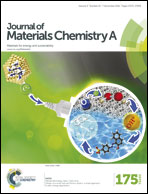Nb2O5 quantum dots embedded in MOF derived nitrogen-doped porous carbon for advanced hybrid supercapacitor applications†
Abstract
Hybrid supercapacitors (HSCs), which are expected to possess the good characteristics of both lithium batteries and supercapacitors, have become a hot research topic in recent years for catering to the growing market for electric vehicles (EVs) and hybrid electric vehicles (HEVs). Herein, we demonstrate an advanced hybrid material construction by the orthorhombic Nb2O5 quantum dots embedded in nitrogen-doped porous carbon derived from ZIF-8 dodecahedrons, referred to as NQD–NC. Then the applications of this material in LIBs and HSCs are studied in-depth. The LIB test reveals that the novel Nb2O5-based material shows excellent high-rate capability and long-term cyclic stability. Importantly, by assembling a HSC device using a NQD–NC anode and a commercial activated carbon cathode with an organic electrolyte, the HSC shows superior electrochemical performance including ultra-high energy and power density (76.9 W h kg−1 and 11 250 W kg−1, respectively) and superior cyclic stability (capacity retention of ∼85% at 5 A g−1 after 4500 cycles in a voltage range of 0.5–3.0 V). The excellent electrochemical performance of the HSCs indicates combining the advantages of lithium-ion batteries and supercapacitors, which is promising for the next generation of energy storage systems.


 Please wait while we load your content...
Please wait while we load your content...